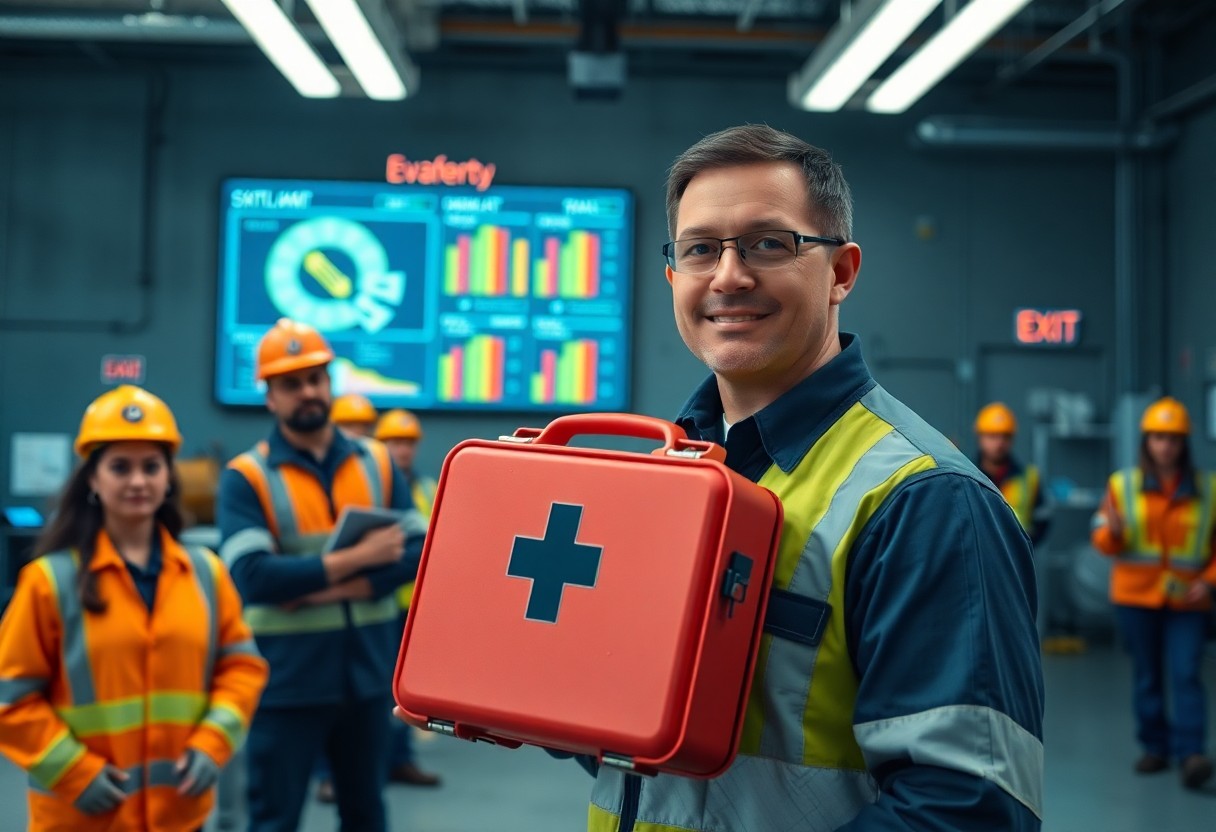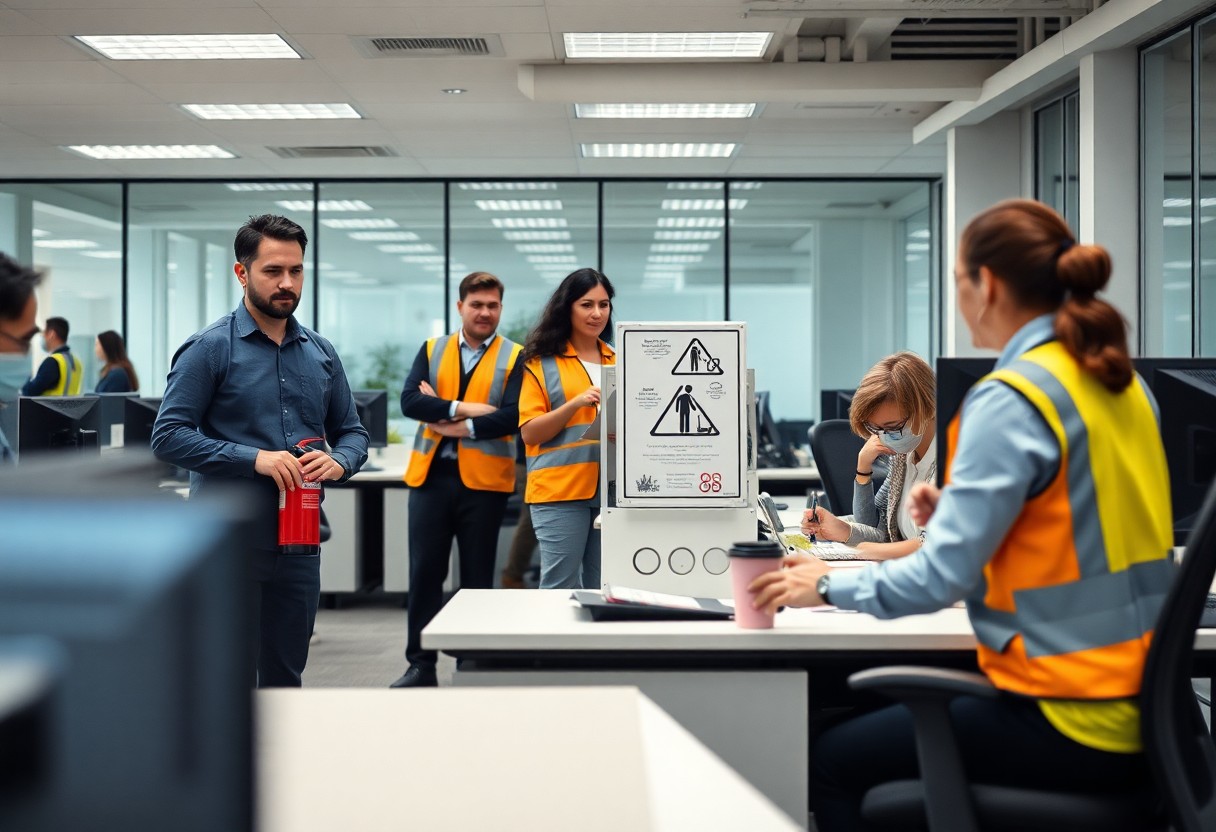Workplace safety is a vital component of a productive environment, and it is your responsibility to enhance it daily. By implementing proactive measures and fostering a safety-first culture, you can significantly reduce risks and protect yourself and your colleagues. This list outlines 10 important steps you can take, ensuring that safety becomes an integral part of your workplace routine. Adopting these practices will not only contribute to a safer working environment but also boost morale and productivity across the board.
Key Takeaways:
- Implement regular safety training sessions for all employees to enhance awareness and skills.
- Conduct daily inspections of work areas to identify and mitigate potential hazards.
- Encourage open communication regarding safety concerns, allowing employees to report issues without fear.
Cultivating a Safety-First Culture
To cultivate a safety-first culture, you must embed safety into the core values of your workplace. This means leading by example, prioritizing safety in all operations, and ensuring that every team member understands their role in maintaining a safe environment. By fostering a culture where safety is seen as everyone’s responsibility, you can enhance engagement and reduce workplace incidents significantly.
Encouraging Open Communication
Encouraging open communication is key to a safety-first culture. You should create an environment where employees feel comfortable voicing concerns and reporting unsafe practices without fear of repercussions. Regular safety meetings and feedback channels can facilitate this dialogue, ensuring that everyone is aware of potential hazards and their roles in mitigating them.
Recognizing and Rewarding Safe Behaviors
Recognizing and rewarding safe behaviors reinforces the importance of safety in your workplace. By acknowledging individuals who consistently practice safety measures, you encourage others to adopt similar standards. Regularly highlight these behaviors in team meetings or through company communications to emphasize their value.
Incorporating a systematic approach to recognizing and rewarding safe behaviors can lead to lasting improvements in workplace safety. You might implement an incentive program that offers rewards for employees who demonstrate commitment to safety protocols or report hazards. These rewards could range from simple acknowledgments to tangible benefits like gift cards. By making safety a celebrated part of your workplace culture, you motivate your team to prioritize safety in their daily routines, fostering a collective responsibility for maintaining a safe environment.
Comprehensive Training Programs that Stick
Implementing comprehensive training programs is necessary to foster a culture of safety in your workplace. You must develop a curriculum that covers relevant safety protocols, emergency procedures, and hazard recognition, ensuring that every employee understands their role in maintaining a safe environment. Regularly updating these programs will help reinforce key concepts and ensure that safety remains a priority for all staff.
Tailoring Training to Specific Roles
To maximize the effectiveness of your training programs, tailor them to the specific roles within your organization. You should assess the unique challenges and risks associated with each position, enabling you to address those issues directly. By customizing training content to fit the needs of various teams, you empower your employees to better identify hazards and implement appropriate safety measures.
Utilizing Interactive Training Methods
Interactive training methods engage employees more effectively than traditional lectures. You can incorporate simulations, hands-on exercises, and collaborative group activities to enhance learning. These approaches encourage participation and allow you to gauge comprehension, fostering a more dynamic training environment that promotes retention of safety information.
Utilizing interactive training methods not only increases engagement but also makes learning more relevant and practical for your employees. You can use role-playing scenarios that mimic real-life situations they might encounter on the job. By bringing safety concepts to life in a controlled environment, employees can practice their responses and reinforce their understanding. This hands-on approach ensures that safety training is not merely theoretical but a vital part of their daily routine in the workplace.
Hazard Identification and Reporting Made Simple
Effective hazard identification is imperative for maintaining workplace safety. You can simplify the process by using clear reporting procedures and encouraging open communication among your team. Regularly assess your work environment for potential hazards, and create a culture where reporting concerns is welcomed. By staying proactive, you contribute to a safer workplace for everyone.
Implementing Regular Safety Audits
Conducting regular safety audits allows you to systematically identify and address potential hazards. Schedule these audits at consistent intervals to ensure your workplace remains compliant with safety standards. Use the findings to create actionable plans, and involve your team in the process to foster a sense of ownership and responsibility.
Empowering Employees to Report Concerns
Creating a supportive environment for reporting safety concerns is vital for maintaining workplace safety. You should encourage your employees to voice their observations without fear of repercussions. Provide training on how to identify hazards and report them effectively, ensuring they feel confident in their ability to contribute to a safer work environment.
Empowering employees to report concerns involves fostering a culture of trust and transparency. You can implement anonymous reporting systems to alleviate any fear of backlash, and regularly remind your team that their observations are valued. Acknowledge and act on reports to demonstrate your commitment to safety. This engagement helps build a unified front against hazards and reinforces the importance of collective responsibility for workplace safety.
Proper Equipment and Ergonomics
To enhance workplace safety, you must prioritize proper equipment and ergonomics. Ensuring that your tools and workstations are designed for safety not only reduces the risk of injuries but also improves overall productivity. Using the right equipment tailored to your tasks can significantly mitigate hazards while promoting comfort throughout your workday.
Assessing the Need for Protective Gear
Evaluate your work environment to determine the need for protective gear. Identify potential hazards specific to your tasks and ensure that appropriate personal protective equipment (PPE) is available. Regularly review safety protocols and make adjustments based on the evolving nature of your work to keep your safety measures relevant and effective.
Designing Workspaces for Comfort and Safety
Creating an ergonomic workspace is key to both comfort and safety. Configure your workstation to fit your body’s needs, incorporating adjustable furniture, optimal screen placement, and accessible tools. This thoughtful arrangement minimizes strain, preventing repetitive stress injuries, and allows you to perform tasks efficiently while maintaining a safe environment.
In designing workspaces for comfort and safety, focus on elements that enhance both ergonomics and functionality. Arrange tools within easy reach and ensure that seating promotes good posture. Provide adequate lighting to reduce eye strain and install anti-slip flooring to prevent falls. Taking the time to implement these strategies will lead to a more effective and enjoyable work experience, ultimately reducing injury risks and boosting morale.

Proactive Emergency Preparedness
To enhance safety in your workplace, proactive emergency preparedness is vital. This involves anticipating potential hazards and planning responses to emergencies before they occur. By developing comprehensive strategies, you can minimize risks and ensure that everyone knows how to act swiftly and efficiently during critical situations.
Creating and Practicing Emergency Plans
Creating and practicing emergency plans is an important step in workplace safety. You should identify potential emergencies specific to your environment and develop clear procedures for each scenario. Regular drills not only familiarize employees with these plans but also help identify areas for improvement in your response strategies.
Establishing Clear Communication Channels
Establishing clear communication channels is key to effective emergency response. You need to ensure that all employees know how to receive and relay information during a crisis. This includes using multiple platforms, such as alarms, intercoms, or messaging apps, to reach everyone quickly and accurately.
To create effective communication channels, assess various methods that work best for your workforce. Implement a reliable system for disseminating information quickly, ensuring that all employees are trained to use it. Regularly test and update these channels to adapt to any changes in your workplace structure or technology. By prioritizing clear communication, you strengthen your overall preparedness and response during emergencies.
Continuous Improvement Through Feedback
To enhance workplace safety, actively seek feedback from employees, empowering them to share their insights and concerns. Establishing a culture of open communication not only fosters trust but also reveals valuable information about potential hazards and risks. By continuously integrating feedback into your safety practices, you create an environment focused on ongoing improvement and employee well-being.
Conducting Safety Surveys Regularly
Regular safety surveys allow you to gauge employee perceptions of safety protocols and identify areas for enhancement. By creating and distributing these surveys, you encourage participation and input from your team, ensuring a comprehensive understanding of workplace safety dynamics. Use the insights gained to inform your strategy and make necessary adjustments to policies and procedures.
Analyzing Incident Reports for Trends
Examining incident reports helps you identify recurring issues and trends that may pose risks to your workplace. By scrutinizing these reports, you can pinpoint specific hazards and evaluate the effectiveness of existing safety measures. This proactive approach enables you to develop targeted solutions to mitigate risks and enhance overall safety.
When analyzing incident reports, focus on common factors such as location, timing, and types of incidents. Categorizing data can reveal patterns that may go unnoticed otherwise. Implement a systematic process for tracking these incidents over time, allowing you to assess whether your safety interventions are effective or if further action is needed. Engagement with employees during this analysis can also provide deeper insights into the root causes of incidents, leading to more effective preventive measures.
Summing Up
Considering all points, implementing these 10 necessary steps can significantly enhance workplace safety every day. By being proactive in identifying hazards, encouraging open communication, and engaging in regular training, you create a safer environment for yourself and your colleagues. Prioritize safety measures, utilize resources effectively, and foster a culture of accountability. Your commitment to these practices not only protects you but also contributes to the overall well-being of your workplace.
FAQ
Q: What is the first step to improve workplace safety every day?
A: The first step is to conduct a thorough assessment of the workplace to identify potential hazards. This includes reviewing equipment, processes, and employee practices to understand areas that require improvements or interventions.
Q: How can ongoing training contribute to workplace safety?
A: Ongoing training ensures employees are aware of safety protocols and procedures. Regular training sessions help reinforce safety practices, educate staff on new risks, and provide updates on emergency procedures, fostering a culture of safety.
Q: Why is communication important for workplace safety improvements?
A: Effective communication allows for the sharing of safety concerns, encourages employee feedback, and promotes transparency regarding safety practices. It ensures that everyone is informed about procedures and can contribute to a safer work environment.
